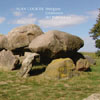Alan Courtis, "Antiguos Dólmenes del Paleolítico "
 A founding member of the late Argentinian trio Reynols, Courtis is no stranger to extreme media. Past works like symphonies for blank tapes, chickens, quartets for whistling kettles, and one piece called Reynols Plays The Eiffel Tower make a record of no-input feedback sound rather tame. And it is, in the best way.
A founding member of the late Argentinian trio Reynols, Courtis is no stranger to extreme media. Past works like symphonies for blank tapes, chickens, quartets for whistling kettles, and one piece called Reynols Plays The Eiffel Tower make a record of no-input feedback sound rather tame. And it is, in the best way.
Inspired by ancient rock structures, presumed tombs like stone hallways, Antiguos Dólmenes del Paleolítico is not a composition of pummeling, monolithic noise but a quiet work of blank insistencies, as if Courtis is looking for essential structures when he looks at these rocks, not for history, or calm, or any kind of presence. The piece comes divided into four distinct parts: not monotonous but planar in their construction; never entering the granular, overblown textures susceptible in feedback play or the painstaking prickly landscapes of someone like fellow-no-inputer Toshimaru Nakamura. Courtis’ method is more in the spirit of drone, a twining of cyclical, throb-like modulations on patient, studious trajectory; even at their most shrill (please expect them to get as shrill as they do subterranean), their focus is meditative, a contemplation of spaces, like distant bells echoing across water, signals of the void.
Courtis manages to mingle tones in a dynamic and repetitive way, never overloading or resorting to womb-y crescendos that would compromise such delicate, static advance. The tense, but comfortably insistent higher frequencies (especially in Parts II and IIII) remind of later works by Morton Feldman where shrill woodwinds chiming the same note at regular interval affect a dual monotony by becoming both the piercing pacemaker and grateful grounding to a super-long shallow composition. The third of Antiguos’ four parts abandons the drone-y construction of twining pure tones dominating the other parts, taking instead a reverb-heavy chorus of tiny, chirping whines, miniature arabesques of sculpted feedback that sound remarkably like birds, glistening and twinkling as the glints and glyphs from a dolmen-side might.
Knowledge of the ‘pure feedback’ artifice behind music like this becomes a necessary part of the listening process; it’s something that, to me, always feels cheeky and somewhat subversive, certainly a thread running through Courtis’ time in Reynols. Listening to Antiguos, though, I think less about the nature of the sounds or the obsessive nature of this kind of composition (as I might listening to something by Nakamura, or a sine wave piece). Courtis makes it easy to exist alongside these pieces without too much expenditure towards projected form or content. It’s easier to slowly surge along, to enjoy the room I’m in, to think of how genuinely calming and softly electric a throb can feel, or how living out near some really big rock piles would feel too.
samples:



